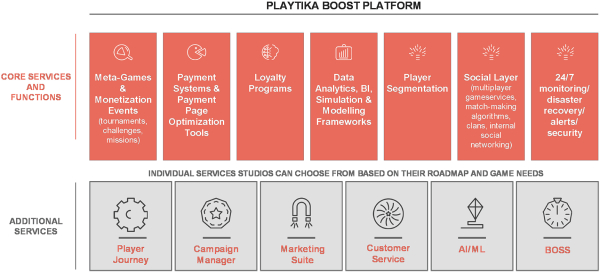Mobile technology has reshaped the role that games play in our lives. Driven by the expansion of mobile broadband and the proliferation of smartphones, games today can be enjoyed whenever and wherever players want.
According to Newzoo, approximately 2.5 billion users spent time and money on mobile games in 2019. Mobile gaming revenue is expected to grow to roughly $114.4 billion in 2023, representing a compound annual growth rate of 9.8% from $86.3 billion in 2020.
As players increasingly look for entertainment at home and on the go, accessing a library of games and connecting with others worldwide without the need to dedicate a specific amount of time to the activity enhances the appeal of mobile gaming.
The most successful free-to-play games require the consistent introduction of new content, offers, and features, a highly quantitative approach to managing in-game economies, and a design that is engaging either as a primary source of entertainment or as a second screen.
Mobile games have become a compelling way for people to interact with family and friends and even build new game-based relationships. By integrating social features like gifting, messaging, and leaderboards, users become more immersed as they find other players with similar playing habits, interests, and levels of engagement.
Playtika is on a mission to entertain the world through infinite ways to play. Playtika generated $2.6 billion in revenue through 34 Million MAUs in just 11 years. Hence we got intrigued to learn about the business model of Playtika and how it works. We will also do a competitor analysis of Playtika. Let’s find out.
Playtika’s business overview
Playtika, founded in 2010, is an Israel-based digital entertainment company specializing in developing and publishing mobile casino games. Robert Antokol founded Playtika when he saw the potential to be first-movers in two nascent market opportunities.
- The first was the launch of game platforms by social networks like Facebook, and
- the second was the emergence of the freemium business model across digital platforms.
To maximize its chance of success, Playtika focused on classic games that people have played for many years, such as slots, bingo, poker, and solitaire. Due to rising competition, Playtika needed help to sustain itself. In May 2011, the company was bought by Caesars Entertainment Corporation. Antokol remained the CEO of Playtika, and the company remained an independent unit within Caesars.
Playtika took a fundamentally different approach to operating games. In the gaming industry, games are often viewed as having finite lifespans. When introduced, they leverage fresh content to start strong and fade over time as users become familiar. Playtika took the opposite position and instead sought to operate games as platforms that users could interact with for decades.
Playtika has productized its data analysis, marketing, and monetization know-how into a technology platform called the Playtika Boost Platform. The Playtika Boost Platform provides its game operators with a compelling suite of tools for operating their games successfully, including marketing, player communication, customer service, data modeling, artificial intelligence, and machine learning, to name a few.

Playtika distributes its games to the end customer through various platforms, such as Apple, Facebook, Google, and other web and mobile platforms, plus its Direct-to-Consumer platforms.
Playtika has primarily grown its game portfolio through acquisitions. Once Playtika acquires games, it enhances the scale and profitability of those games and its business model by applying its live operations services and the Playtika Boost Platform. By leveraging this platform, Playtika’s game studios can dedicate more time to creating innovative content, features, and experiences for players.
How does Roblox make money | Business Model
One of Playtika’s fundamental principles is to provide consumers with compelling mobile entertainment experiences that can be played for years. Playtika achieves this aim by employing creative and technical staff, including storytellers, coders, artists, and data scientists.
The Playtika Boost Platform includes
- Meta-games and monetization events, including tournaments, challenges, and missions
- Payment systems and payment page optimization tools
- Loyalty programs
- Data analytics infrastructure, including business intelligence, simulation, and modeling frameworks and dashboards
- Tailored user data, including segmentation and grouping, enabling customizable content curation
- Social gaming infrastructure, including multiplayer game services, match-making algorithms, clans, and intra-game social networking; and
- Customer service, monitoring, disaster recovery, alerts, and security
The Playtika Boost Platform allows Playtika to analyze data across the entire user lifecycle—from user acquisition through monetization and retention. With 34 Million+ MAUs, Playtika can use its scale to gain significant insight into the operations of its games and refine and implement effective strategies concerning feature innovation, content cadence, loyalty rewards, game economies, and player segmentation.
Playtika’s acquisition strategy is the core reason for its exponential strategy. Playtika acquires game studios at attractive prices and achieves meaningful synergies from those games by leveraging its live operations services. 33% of games (as of 2021) in Playtika’s portfolio are through acquisition.
How does Playtika make money? What is the business model of Playtika?
Product (Games Portfolio)
Playtika’s portfolio includes 24 games, of which the top ten games collectively represented 98.9% of its revenues in 2021. Many of its games are classics with mass appeal due to their highly engaging game mechanics.
Playtika’s top 10 games are Slotomania, Bingo Blitz, House of Fun, Solitaire Grand Harvest, June’s Journey, Caesars Slots, World Series of Poker, Best Fiends, Board Kings, and Redecor.
Playtika creates features and player experiences that optimize player engagement, resulting in increased conversion and monetization. Playtika focuses on implementing and enhancing features that keep games fresh and increase user engagement, including awarding in-game virtual items, providing engaging new game themes, motifs, challenges, and in-game missions, as well as in-game chat and messaging capabilities.
Marketing and Player Lifecycle Management
Playtika’s success stems from a deep and nuanced understanding of the critical aspects of data-based marketing strategies applicable to the gaming industry, including how to measure successful user acquisition as it relates to mobile games, where to allocate marketing spend, how to optimize media buying budgets, and how to design ads that attract users who are likely to install and play its games.
How does Twitch make money | Business Model
Playtika develops tailored monetization and retention strategies for different parts of users’ lifecycles, including before they become paying users after they become paying users, and for users who become inactive.
Payback period-oriented approach to user acquisition: Playtika’s user acquisition strategy focuses on a payback period approach, emphasizing monetization efforts that recoup its marketing spend during a reasonable timeframe.
Re-targeting: Playtika uses re-targeting campaigns to reactivate inactive users, mainly as many of its games were released several years ago. Playtika leverages these investments to create personalized re-targeting campaigns to re-engage former users.
How does Playtika make money: revenue model
Playtika made $2.6 billion in 2021, an 8% increase from 2020. Playtika’s games are free-to-play. Playtika primarily makes money from selling virtual items associated with online games to users looking to enhance their game-playing experience.
Playtika’s games are played primarily on various third-party platforms for which the platform providers collect proceeds from its customers and pay Playtika an amount after deducting platform fees.
Playtika has a freemium business model in which its games are free-to-play. Still, Playtika makes money through in-app purchases, including the sale of virtual currency and items, and, to a much lesser extent, through in-app advertising.
Product-wise segmentation of revenue: Playtika’s portfolio includes both casual and casino-themed games. In 2021, casual games generated 48.7% of revenues, with casino-themed games accounting for the remaining 51.3%.
Platform-wise segmentation of revenue: Playtika’s games are played primarily on various third-party platforms for which the platform providers collect proceeds from customers and pay Playtika an amount after deducting platform fees. Playtika derived 80% of its revenues in 2021 from third-party platforms and 20% from its Direct-to-Consumer platforms.
Business-wise segmentation of revenue:
- Playtika derived 97.1% of its revenues in 2021 from in-game purchases. Paying users usually spend money on its games because of the perceived value of the virtual items that Playtika offers for purchase.
- A growing portion of Playtika’s revenues is generated from the sale of in-game advertisements. Playtika derived 2.9% of its revenues in 2021 from in-game advertising. Playtika has relationships with certain advertising service providers for advertisements within its games, and revenues from these advertising providers are generated through impressions, clickthroughs, banner ads, and offers.
How does DraftKings make money: Business Model & Marketing Strategy
Competitor Analysis of Playtika
Playtika’s biggest competitors are Tencent Holdings, Activision Blizzard, Electronic Arts, Take-Two, Zynga, AppLovin, and Product Madness/Big Fish Games. In 2020, Playtika accounted for 22 percent of the global social casino gaming market.
Playtika competes for its players’ leisure time, attention, and discretionary spending versus other forms of offline and online entertainment, including social media, reading, and other video games.
Playtika’s competitors enjoy substantial competitive advantages, such as greater name recognition, longer operating histories, and more significant financial, technical, and other resources.
Internationally, local competitors may have greater brand recognition than us in their local country and a more robust understanding of local culture and commerce. They may also offer their products and services in local languages Playtika does not offer.
The gaming industry is highly competitive, rapidly evolving, fragmented, and subject to changing technology, shifting needs, and frequent introductions of new games, development platforms, and services.
Playtika’s success over its competitors would depend on its continuous ability to attract and retain players, expand the game market, convert inactive players into paying users, maintain a technological edge and offer new capabilities to players.
















